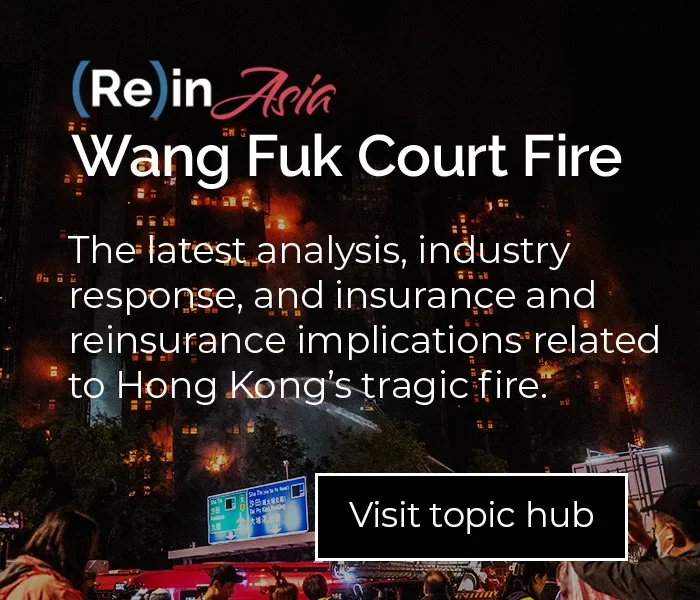(Re)in Summary
• Industry leaders at SIRC said AI will continue to reshape risk modelling, underwriting, and workforce roles in (re)insurance.
• AI enables faster integration of third-party data to improve risk mitigation and can help to measure outlier events.
• However, the tech shows plenty of potential to measure risk beyond claims; for example, it allows reinsurers to compare risk profiles for cedents more quickly.
• With AI set to continue to automate routine tasks, leading (re)insurance professionals are focusing more on talent who have strong soft skills and can build client relationships.
Artificial intelligence (AI) will reshape risk modelling, underwriting, and workforce structures across the (re)insurance sector, industry leaders said at the Singapore International Reinsurance Conference on 5 Nov, as firms continue to embed the technology into core operations to strengthen risk mitigation and efficiency.
A good example is catastrophe and risk modelling, where AI allows faster integration of third-party data into models, reducing uncertainty in (re)insurers’ pricing, said Glen Riddell, Chief Executive Officer for Asia Pacific at Berkley Re.
“We’re kind of at the very early stages of this, but you can see where it goes, because it’s all built on data,” Riddell says. “The reinsurance industry loves data; it’s evidence-based thinking, so you can see how it can start to reduce the uncertainty of forecasting models, and I think some of the catastrophe modelling firms will be using this in a very big way.”
With added data, AI should also be able to predict and measure the risk of more outlier events — and tech firms can help insurers in creating these simulations and models, says Vishnu Nanduri, head of AI and Innovation at enterprise technology services firm Kyndryl.
“These days, we have the ability to spawn multiple agents to find the right kind of datasets through API calls, and do these simulations a lot faster than what we were ever able to do,” he added. “That’s probably how the (insurance) domain expertise and the AI expertise can come together to really try to address a really fundamental challenge.”
Risk mitigation
Having more data will also give insurers a clearer picture of risk profiles and mitigation strategies.
Providing an example, Philip Weiner, chief executive officer for APAC at bolttech, said that reinsurers who adopt AI early can assess the effectiveness of risk mitigation measures and identify cost savings for insurers and policyholders, giving them a “key competitive advantage.”
“(Reinsurers) get that data first… They get ‘okay, does this preventative action work? Let’s understand that, and then I can grow and expand that line of business,” Weiner said.
Echoing this, Bertrand Romagne, Chief Executive Officer for international reinsurance at AXA XL Reinsurance, suggested that while AI changes how the probability of loss events is measured, it can also change how (re)insurers define their roles. “Maybe the next step of our job is not to say we will insure people, it’s: what are we going to do so that there is no loss.”
And the potential for risk management extends beyond measuring potential claims.
Reinsurers, for example, could compare risk profiles for cedents more quickly, so they can choose the cedents that are doing business “the way we want them to”, said Romagne.
“Maybe in the future, by having access to all the data, we will be actually able to say, well, this company is actually doing a better job than this one,” Romagne added. “On the reinsurance side, it’ll help us select the companies that are doing business the way we want them to do business.”
All this comes as AI fundamentally changes the skillsets in demand for (re)insurance professionals, transforming traditional job roles.
“I think AI will become sort of a central nervous system for many insurers and reinsurers,” said Nanduri.
In five years, there’ll be a proliferation of AI agents that will work alongside (re)insurance professionals and automate tedious tasks, Nanduri said, so professionals can do “other intelligent work”. “I see that as the future of many organisations, and very importantly for insurers and reinsurers,” he added.
Trust still key
But as AI transforms risk management and underwriting by bringing automation efficiencies into the value chain, (re)insurers are grappling with compliance and risks in places where data is being analysed and used, and the industry is taking a step back to ensure guardrails are in place.
“We’re sort of in this pause at the moment, making sure that we’ve got the right protections,” said Riddell.
Regulators are paying attention to how data privacy issues are being addressed with the increasing use of AI, he also points out.
“When we do our quarterly reviews with our regulators, sometimes the first question they’re (raising) is: what are you doing in AI, and how is that affecting your protection of client data?” Riddell said.
Across APAC, regulators are tightening oversight through new or draft laws, emphasising accountability, transparency, and human oversight and setting clearer liability standards. “It’s front of mind for them at the moment.”
But these are not rules that should just be bolted on, said Nanduri. “When you develop any AI model, you want to make sure that these seven fundamental principles are baked in,” he said.
(Re)insurers should speak with regulators and engage with them about AI development and AI-driven solutions, said Beth Diamond, group chief claims and litigation officer at Beazley.
It’s not just (re)insurers who are looking into using AI solutions — vendors and firms (re)insurers work with will want to use AI as well. “And they’ll be using your data,” Diamond said. “They’ll be working for you on your project that you’ve hired them for using artificial intelligence, and you want to know how they’re using that material so that you don’t get caught off guard.”
Having safeguards in place is a good way for organisations to find a balance between innovation and risk, Diamond added.
“You have to balance the cheerleader with the police officer with the stop sign,” she said. “You have to find a way to encourage to build, to explore and develop, but in a way that is measured and fits your organisation and your organisation’s appetite.”
Workforce revolution
AI has become central to business functions across the (re)insurance value chain, from distribution to underwriting, claims, customer service and fraud detection, contributing to efficiency and work-life balance.
“For now, it’s augmenting our work. It’s enabling productivity,” said Neetha Nair, chief human resources officer at Prudential Singapore. “It’s not a performance tool yet. I’m sure in future it would be.”
From how meeting minutes are taken by AI and summarised and how policy wordings are examined and analysed, AI has quietly changed how people work for the last five years, said Tony Gallagher, Chief Executive Officer in Asia Pacific at Guy Carpenter.
“If I sort of step back five years, it’s changed (work) quite substantially,” he said. “There’s a lot of little things going on which change the way that I do work, and not only me, but at every level in the organisation, there are things going there which are positively impacting the business.”
With insurtechs, AI has become central to their workforce. Instead of measuring how AI has automated or made a process more efficient, bolttech is now looking at where humans are involved in the value chain, said Weiner. “That’s kind of where we’re eventually going, and it’s very exciting to sort of be at the start of that transition towards that new way of working and thinking.”
This has meant a change in expectations and skill sets for professionals in the (re)insurance industry, as more tedious tasks are automated and professionals focus more on soft skills.
“In five years’ time, the people who have more manual roles will upskill those as an industry, into more soft skills,” said Riddell. “As a CEO, I’ll be looking for those people that can play in the grey, people that have got the soft skills, high in emotional intelligence.”
Increasing efficiencies will mean that those in (re)insurance will find themselves taking part in more relationship-focused work. “By being more efficient with everything that AI is offering you, we can be close to the client,” said Rosa. “In the important things, things that really matter, you can be with a client.”
With AI, there will be an evolution of skillsets at every layer, said Nair. Given evolving trends, organisations are shifting, changing and evolving flatter structures so they have lesser management overheads, and leaders are now having to make decisions about adopting new technology that’s coming through.
“Today’s leaders, myself included, are definitely least savvy compared to the other generations you know below us, and we are finding it challenging to keep adopting all the new technology that’s coming through,” Nair added.
(Re)insurers also “have a moral responsibility” to keep their workforce relevant, said Nair. “Training them on whatever other skill sets that are required to keep them relevant in future is something that as an organisation, I think we need to continue to invest in.”
But professionals will have to be self-driven through a lot of the learning, Nair pointed out — and have learning agility.
“The technology—genAI, agentic AI—we have today may change in six months, and then you again go to learn and relearn,” Nair said. “So the continuous ability to unlearn, learn, relearn—all of that—that’s what’s important.”
























